Sunday, December 25, 2005
channukah has finally arrived and praise he lord blessed be he we are making major kiddushin hashem I put a 5 and a half foot menorah in three different banks in different areas of Sydney one in bondi junction one in bondi beach and one in double bay
here is a pic of me transporting one of the menorahs to the bank
and last night we had a massive parade 104 menorahs that went to Martin Place where we lit a 30 Ft menorah the brochos were said by rabbi pinchas feldman and his son rabbi yossi feldman and the actual lighting was expertly performed by chaim litvin the menorah was put up the night before by a couple bochurim namely mendy weiss shmully davidof yanky bigs yanky levy mendel jaffe chaim litvin yitzi spalter shmulik and yitzchok the truck driver
during the parade we passed the world famous Oprah house with my trailer and 7 Ft menorah
and here is a pic of me two stories up on a plank of sagging wood on a scafold put together by 3 bochurim in a rush they say blind faith is a good thing and i believed them
here is a pic of me transporting one of the menorahs to the bank
and last night we had a massive parade 104 menorahs that went to Martin Place where we lit a 30 Ft menorah the brochos were said by rabbi pinchas feldman and his son rabbi yossi feldman and the actual lighting was expertly performed by chaim litvin the menorah was put up the night before by a couple bochurim namely mendy weiss shmully davidof yanky bigs yanky levy mendel jaffe chaim litvin yitzi spalter shmulik and yitzchok the truck driver
during the parade we passed the world famous Oprah house with my trailer and 7 Ft menorah
and here is a pic of me two stories up on a plank of sagging wood on a scafold put together by 3 bochurim in a rush they say blind faith is a good thing and i believed them
Monday, December 19, 2005
NEWS FROM WARSAW
On the day of the Rebbe's wedding the shluchim in Warsaw chose to farbreng in the original location of the historical wedding that took place in the city77 years ago. The temimim/shluchim in the yeshiva opened the event at the location of Rebbe's chuppah where they sang the 'Arba Bavos'. The tomim, Mordechai Shmuel Lightstone described the sequence of events at the Rebbe's wedding and the tomim Chezki Wolf followed up with inspirational thoughts. The crowd then headed for the location of kingly 'seudas mitzvah' (wedding meal) was held and they all said a merry 'lechayim' and celebrated with dancing and singing. From there they proceeded to the yeshiva hall where they held a farbrengen with members of the local Jewish community
Reading The Yoman

place of chupah
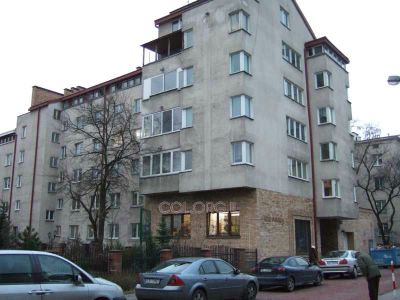
stam

place of chupah

Place Of Hall

Danicng by the Hall
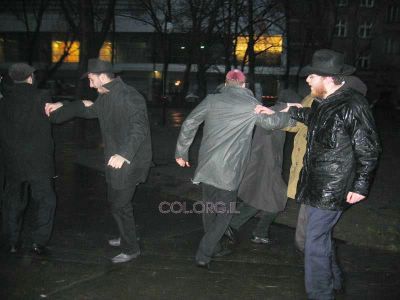
dancing in zal

eating

satalite Photo Place of The Hall

Satalite photo Place Of Yeshivah
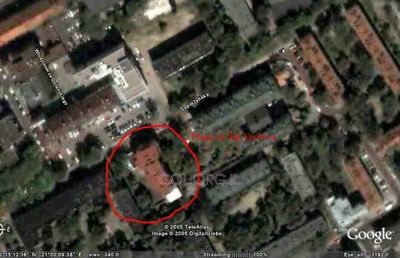
In Front Of Where The Yeshiva Was!

Singing The Alter Rebbes Nigun
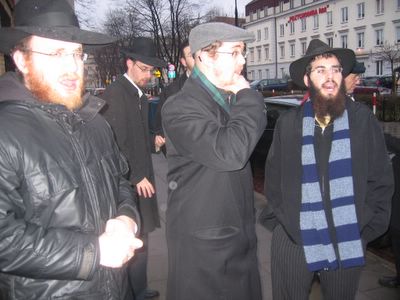
Chesky Wolff Saying Lchaim And Dvar Malchus!

Daled BoVos!
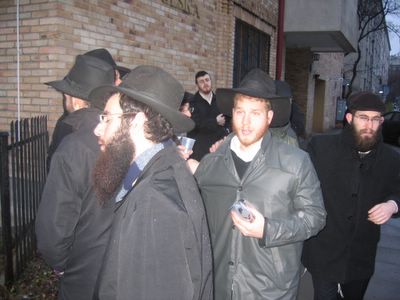
Chesky Giving Lechaim out!
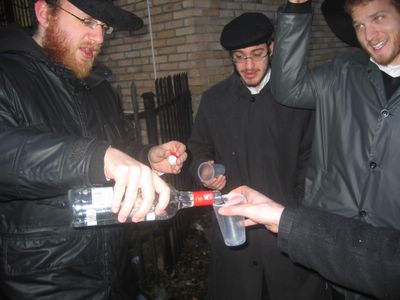
In Front Of Where The Hall Was
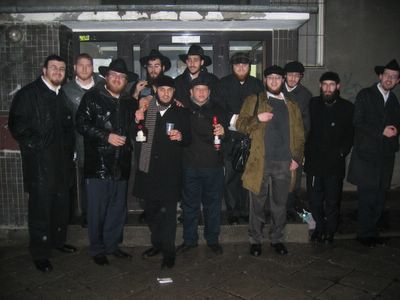
Dancing on the Spot where the hall was!



ביום חתונתו של הרבי יצאו שלוחי חב"ד בוורשא לחגוג ולהתוועד במקום בו נערכה החתונה לפני 77 שנים. התמימים השלוחים בישיבה הפועלת בעיר, פתחו את האירוע המרגש במקום שהוצבה חופתו של הרבי ושם ניגנו את ניגון הד' בבות. הת' מרדכי שמואיל לייטסטון תיאר בפני הנוכחים את סדר חתונתו של הרבי ולאחריו סיים הת' חזקי וולף בדברי התעוררות
משם פנה הקהל למקום שבו נערכה סעודת המצוה ברח' פנסקה שבו הרימו הנוכחים כוסיות 'לחיים' ויצאו בריקוד סוער. לאחר הארועים באתרים ההיסטוריים חזר הקהל לישיבת חב"ד להתוועדות חגיגית שערכו עם בני הקהיל המקומית
Reading The Yoman


place of chupah


stam


place of chupah


Place Of Hall


Danicng by the Hall


dancing in zal


eating


satalite Photo Place of The Hall


Satalite photo Place Of Yeshivah


In Front Of Where The Yeshiva Was!


Singing The Alter Rebbes Nigun


Chesky Wolff Saying Lchaim And Dvar Malchus!


Daled BoVos!


Chesky Giving Lechaim out!


In Front Of Where The Hall Was


Dancing on the Spot where the hall was!




chanukah is coming all over the world but it comes in Australia first
chanukah is coming all over the world but it comes in Australia first
Well chanukah is coming and it won't wait for anyone so I really gotta go because there a lot to do and less time to do it in so I will post some pics and go back to building the rest of the 104 menoahs for my parade and 3 5 ft ones to put in fornt of three of sydneys biggest banks{I know a guy who knows a guy to get that done} and I have lots to do for this chanukah at the bay party where I'm expecting 5000 people and I have to go pick up a menorah in a truck that I didn't rent yet so I really got to go





oh and by the way today I got pulled over for an alleged drunk driving charge but I passed the breathalizer test and the bloody copper let me go apparently there are some rioghts in the area I was going threw and I must have forgotten to take of my turban or something

here is the car I didn't get pulled over in

and here is the car I did get pulled over in

this is a bloody speed camera or red light camera that helps the pd give over 500 tickets per day
but you cant catch me I'm the ginger bread man
enjoy gut yomtov I'm gonna go farbreng
ttypl
Well chanukah is coming and it won't wait for anyone so I really gotta go because there a lot to do and less time to do it in so I will post some pics and go back to building the rest of the 104 menoahs for my parade and 3 5 ft ones to put in fornt of three of sydneys biggest banks{I know a guy who knows a guy to get that done} and I have lots to do for this chanukah at the bay party where I'm expecting 5000 people and I have to go pick up a menorah in a truck that I didn't rent yet so I really got to go





oh and by the way today I got pulled over for an alleged drunk driving charge but I passed the breathalizer test and the bloody copper let me go apparently there are some rioghts in the area I was going threw and I must have forgotten to take of my turban or something

here is the car I didn't get pulled over in

and here is the car I did get pulled over in

this is a bloody speed camera or red light camera that helps the pd give over 500 tickets per day
but you cant catch me I'm the ginger bread man
enjoy gut yomtov I'm gonna go farbreng
ttypl
Monday, December 12, 2005
chanukah
Tuesday Dec 27 there will be b"eh a grand channukah party so mendy and I hung up a huge sign about 35 ft long we had to take down the marching to Bethlehem one to put ours up

and the cops came and asked what we were doing but said it was alright and we continued then this guy from a Jewish paper came and asked us some questions for the paper and took some pics of us for the paper
Wednesday, December 07, 2005
Mondays Trip
Before we get started a little humour:

Busted -the two cleaning ladies (the button breaker on the left, the mikva lady on the right) taking a smoking break on our front porch.
As I reported the other day we went on a trip to Majdanek/Lublin (Does not rhyme with Dublin). Note: those pictures with a star next to them were taken by Yankel Adler (see Yankel -I told you that you'd get credit)
*
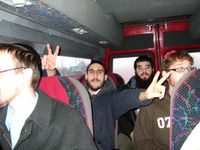
The Van
Our first stop was the Beis Hak'varos (the Graveyard)
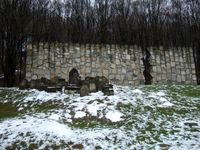
The entrance to the cemetery in Kazimrz the Grave stones were those broken by the Germans and redone as a memorial
Most of the Metzvos (Head Stones) were destroyed, but several could be found standing. Notice the intricately engraved on the stones.

Fallen Matzevos
After we left our tour guide, Thomas (who, though not Jewish, speaks Hebrew and Yiddish -as well as English), took us to the town square -where most of the shops had once been Jewish.
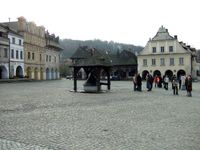
The town square
We took a group picture there:

We saw the old shul -it had been used as a theatre during Communist times, but was now being restored and then set off on our way . . .
Note: Some people are very disturbed by pictures etc. of Concentration camps. If viewing/reading will bring discomfort, please don't let it be on my account, I advise you to skip ahead until you see the next set of Bold letters.
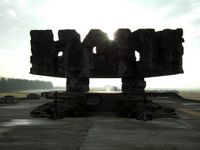
Our first stop in the Lublin area was Majdanek (Pronounced Maydanek -If you haven't heard of it, it's time to do some basic Holocaust reading). Though it was once out in the country, it's now in the middle of the suburbs surrounded by house on two sides.

"Entrance to Hell." One feels himself slowly descending, only to realize that escape is almost impossible.
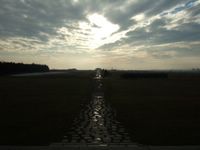
a view of part of the camp
Some Basic History:(taken from Wikipedia) Majdanek is the site of a Nazi concentration and extermination camp, roughly four kilometers away from the center of the Polish city Lublin. Unlike many other Nazi concentration and extermination camps, Majdanek is not hidden away in some remote forest or obscured from view by natural barriers, nor was it surrounded by a "security zone". It was established in October 1941, at Heinlich Himmler's orders, following his visit to Lublin in July 1941. Majdanek was an SS-run prisoner-of-war camp, under the command of Karl Otto Koch. In February 1943, it was turned into a concentration camp.
In October 1942, several female SS troopers arrived from the Ravensbruck camp in Germany, where they were trained. These women included Elsa Erich, Hermine Braunsteiner, Hildegard Lachert and Rosy Suess. Elisabeth Knoblich was one of the ruthless overseers in the camp. She was so brutal and sadistic that even her fellow Aufseherinnen feared her and nicknamed her "Halt Die Klappe" (Shut Your Mouth!). When the Soviets liberated Majdanek, they found unending evidence that pointed to the ruthless attitude of the female overseers.
The camp's name derives from a Lublin district called Majdan Tatarski, and was given it in 1941 by the locals, who were certainly aware of its existence. The original German name of the camp was "Konzentrationslager Lublin" (Concentration Camp Lublin).
At its peak operation, it held about 50,000 inmates. In the early months of 1942, plans were made and approved to expand Majdanek to contain as many as 250,000 inmates. Between April 1942 and July 1944, extermination took place in Majdanek using gas chambers and crematoria. Madjanek was one of two death camps that used Zyklon B in its gas chambers. However, carbon monoxide was also used.
According to the data from the official Majdanek State Museum (see external link below) about 300,000 inmates passed through the camp, with over 40% Jews and about 35% Poles. Other major nationalities included Belarusians, Ukrainians, Russians, Germans, Austrians, French, Italians and Dutch. It is estimated that over 235,000 human lives were lost in Majdanek, including about 100,000 Jews. Majdanek was unique among the death camps in that the Jewish victims did not form an overwhelming majority.
Majdanek provided slave labor for munitions works and the Steyr-Daimler-Puch weapons factory.
The camp was liquidated in July 1944, but the crematoria were all that could be destroyed before the Red Army arrived, making Majdanek the best-preserved camp of the Holocaust. Although 1,000 inmates were evacuated on a death march, the Red Army found thousands of inmates, mainly POW, still in the camp and ample evidence of the mass murder that had occurred there.
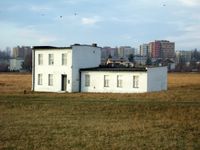
The Hospital for the German Officers
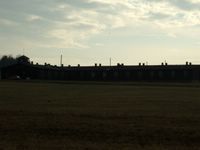
The Lodgings for the SS men.
We then came to the Roll Call grounds, where people were brought when they first arrived, and divided . . .

The chambers, labeled as Baths (so as to calm the victims), at the time they were in use the place was full of roses as well -so as to further deceive those entering Majdanek.

Next were the shower rooms, after shaving off the hair of those about to be murdered (the hair was used to to defray the cost of buying zyklon b), they were herded into the showers so as to calm them (to allay their fears that they were to be killed) and to open the pores in the skin so that the gas can better enter the body.
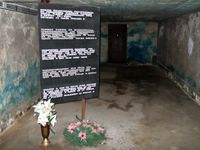
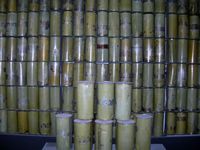
the walls of the chambers, dyed blue by the Zyklon B. Zyklon B
As mentioned, Majdanek is one of the best preserved Concentration camps, however after the war the Poles were in acute need of housing, they therefor broke down three of the four "fields" -bunker units, as well the the dog kennels and other parts of the camp.
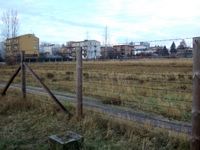
The foundations of a building, notice how today people now live right outside of the camp.
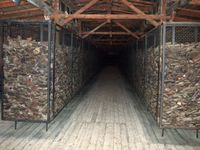 After the war there were over 80,000 shoes left from those murdered. 60,00 were stolen by the poles for their own use -the rest are now on display.
After the war there were over 80,000 shoes left from those murdered. 60,00 were stolen by the poles for their own use -the rest are now on display.

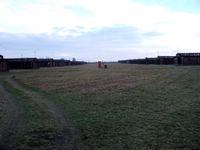
The double barbed wire electric gates.
We then entered the only remaining field, where the inmates lived.

A monument made by inmates on request of the officers so that if the Red Cross were to come the camp would look more hospitable. The artists hid a canister of ashes within the monument -so that it would also serve as a sign of the atrocities that the Germans had done.
We then went to the back of the camp to the most horrid place that I've ever been . .

The camp is full of crows -our guide said that they were the SS and Kapos, come back to spend their lives in their horrid camp. Though I don't know it to be true, it certainly is poetic justice.
*
Approaching the "new" gas chamber/crematorium and mausoleum where 20 containers of human ashes left over by Germans were placed by the Russians as a testimony to the world. It says on it (in Polish) "Let our fate be a warning."
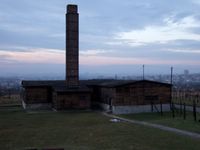
The "new" Gas chamber/Crematorium built during the second half of the war near the back of the camp.


the Gas Chambers A table used to dissect victims who might have swallowed valuables

The Bathtub that belonged to the head Officer, it was heated by the crematorium
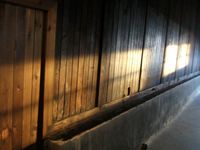
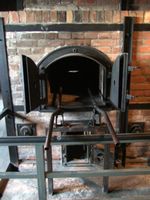
Light entry the crematorium Some pictures need no caption
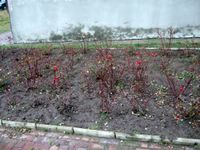
Though these roses are new, it is known that ash from the crematorium was used to fertilize the flowers.
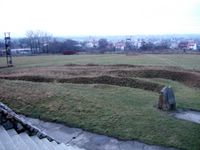
We then went to the mausoleum, passing the mass graves, of 18,400 Jews killed in Majdanek on November 3. That day a total of 42,000 Jews were murdered in the Lublin area. The Germans later dug up the bodies and burned them so that the Russians would not be able to know the exact number of those murdered.
*
We davened Mincha and sang Al Tira: Do not fear sudden terror, nor the destruction of the wicked when it comes. Contrive a scheme, but it will be foiled; conspire a plot, but it will not materialize, for G-d is with us. To your old age Ia am [with you]; to your hoary years I will sustain you; I have made you, and I will carry you; I will sustain you and deliver you.
Indeed, the righteous will extol Your Name; the upright will dwell in Your presence.
On to Lublin:

The Ohel of Reb Tzadok haCohen, Reb Leibele Eiger and his family, in the new Lublin Cemetery. Of the four original cemeteries, two were completely destroyed, and part of the new one was paved over for a road. We then went to the old Bais Hak'varos

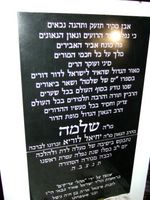
Inside the Choze's Ohel The Maharshal's Ohel
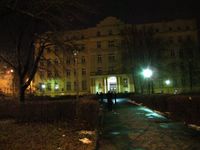
Yeshivas Chachmie Lublin (Taken using Chaim van Helem's head as a tripod)
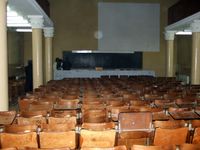
The Zal

The Mikvah
We then went to the old city -Jewish quarter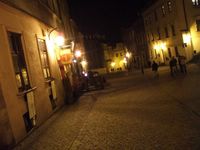
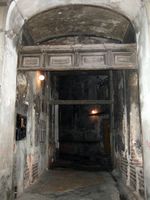
A ghetto house
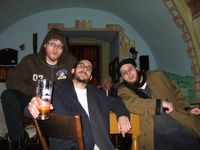
taking a break in a "Jewish" restaurant
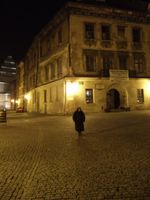
an old lady in the old town
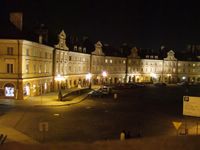
The Town square (Jews were not allowed there)
We then returned to Yeshiva.

Busted -the two cleaning ladies (the button breaker on the left, the mikva lady on the right) taking a smoking break on our front porch.
As I reported the other day we went on a trip to Majdanek/Lublin (Does not rhyme with Dublin). Note: those pictures with a star next to them were taken by Yankel Adler (see Yankel -I told you that you'd get credit)
*


The Van
Our first stop was a small shtetl known Kazimrz (Pronounced Kazhim'sh, known by the Jews as Kuzmir (which sounds a lot like Kush Mir . . .)) It still is in many respects a shtetl -on the way there we saw a guy plowing his field with a horse!
Our first stop was the Beis Hak'varos (the Graveyard)

The entrance to the cemetery in Kazimrz the Grave stones were those broken by the Germans and redone as a memorial
Most of the Metzvos (Head Stones) were destroyed, but several could be found standing. Notice the intricately engraved on the stones.

Fallen Matzevos
After we left our tour guide, Thomas (who, though not Jewish, speaks Hebrew and Yiddish -as well as English), took us to the town square -where most of the shops had once been Jewish.

The town square
We took a group picture there:

We saw the old shul -it had been used as a theatre during Communist times, but was now being restored and then set off on our way . . .
Note: Some people are very disturbed by pictures etc. of Concentration camps. If viewing/reading will bring discomfort, please don't let it be on my account, I advise you to skip ahead until you see the next set of Bold letters.

Our first stop in the Lublin area was Majdanek (Pronounced Maydanek -If you haven't heard of it, it's time to do some basic Holocaust reading). Though it was once out in the country, it's now in the middle of the suburbs surrounded by house on two sides.

"Entrance to Hell." One feels himself slowly descending, only to realize that escape is almost impossible.

a view of part of the camp
Some Basic History:(taken from Wikipedia) Majdanek is the site of a Nazi concentration and extermination camp, roughly four kilometers away from the center of the Polish city Lublin. Unlike many other Nazi concentration and extermination camps, Majdanek is not hidden away in some remote forest or obscured from view by natural barriers, nor was it surrounded by a "security zone". It was established in October 1941, at Heinlich Himmler's orders, following his visit to Lublin in July 1941. Majdanek was an SS-run prisoner-of-war camp, under the command of Karl Otto Koch. In February 1943, it was turned into a concentration camp.
In October 1942, several female SS troopers arrived from the Ravensbruck camp in Germany, where they were trained. These women included Elsa Erich, Hermine Braunsteiner, Hildegard Lachert and Rosy Suess. Elisabeth Knoblich was one of the ruthless overseers in the camp. She was so brutal and sadistic that even her fellow Aufseherinnen feared her and nicknamed her "Halt Die Klappe" (Shut Your Mouth!). When the Soviets liberated Majdanek, they found unending evidence that pointed to the ruthless attitude of the female overseers.
The camp's name derives from a Lublin district called Majdan Tatarski, and was given it in 1941 by the locals, who were certainly aware of its existence. The original German name of the camp was "Konzentrationslager Lublin" (Concentration Camp Lublin).
At its peak operation, it held about 50,000 inmates. In the early months of 1942, plans were made and approved to expand Majdanek to contain as many as 250,000 inmates. Between April 1942 and July 1944, extermination took place in Majdanek using gas chambers and crematoria. Madjanek was one of two death camps that used Zyklon B in its gas chambers. However, carbon monoxide was also used.
According to the data from the official Majdanek State Museum (see external link below) about 300,000 inmates passed through the camp, with over 40% Jews and about 35% Poles. Other major nationalities included Belarusians, Ukrainians, Russians, Germans, Austrians, French, Italians and Dutch. It is estimated that over 235,000 human lives were lost in Majdanek, including about 100,000 Jews. Majdanek was unique among the death camps in that the Jewish victims did not form an overwhelming majority.
Majdanek provided slave labor for munitions works and the Steyr-Daimler-Puch weapons factory.
The camp was liquidated in July 1944, but the crematoria were all that could be destroyed before the Red Army arrived, making Majdanek the best-preserved camp of the Holocaust. Although 1,000 inmates were evacuated on a death march, the Red Army found thousands of inmates, mainly POW, still in the camp and ample evidence of the mass murder that had occurred there.

The Hospital for the German Officers

The Lodgings for the SS men.
We then came to the Roll Call grounds, where people were brought when they first arrived, and divided . . .

The chambers, labeled as Baths (so as to calm the victims), at the time they were in use the place was full of roses as well -so as to further deceive those entering Majdanek.

Next were the shower rooms, after shaving off the hair of those about to be murdered (the hair was used to to defray the cost of buying zyklon b), they were herded into the showers so as to calm them (to allay their fears that they were to be killed) and to open the pores in the skin so that the gas can better enter the body.


the walls of the chambers, dyed blue by the Zyklon B. Zyklon B
As mentioned, Majdanek is one of the best preserved Concentration camps, however after the war the Poles were in acute need of housing, they therefor broke down three of the four "fields" -bunker units, as well the the dog kennels and other parts of the camp.

The foundations of a building, notice how today people now live right outside of the camp.
 After the war there were over 80,000 shoes left from those murdered. 60,00 were stolen by the poles for their own use -the rest are now on display.
After the war there were over 80,000 shoes left from those murdered. 60,00 were stolen by the poles for their own use -the rest are now on display.

The double barbed wire electric gates.
We then entered the only remaining field, where the inmates lived.

A monument made by inmates on request of the officers so that if the Red Cross were to come the camp would look more hospitable. The artists hid a canister of ashes within the monument -so that it would also serve as a sign of the atrocities that the Germans had done.
We then went to the back of the camp to the most horrid place that I've ever been . .

The camp is full of crows -our guide said that they were the SS and Kapos, come back to spend their lives in their horrid camp. Though I don't know it to be true, it certainly is poetic justice.
*

Approaching the "new" gas chamber/crematorium and mausoleum where 20 containers of human ashes left over by Germans were placed by the Russians as a testimony to the world. It says on it (in Polish) "Let our fate be a warning."

The "new" Gas chamber/Crematorium built during the second half of the war near the back of the camp.


the Gas Chambers A table used to dissect victims who might have swallowed valuables

The Bathtub that belonged to the head Officer, it was heated by the crematorium


Light entry the crematorium Some pictures need no caption

Though these roses are new, it is known that ash from the crematorium was used to fertilize the flowers.

We then went to the mausoleum, passing the mass graves, of 18,400 Jews killed in Majdanek on November 3. That day a total of 42,000 Jews were murdered in the Lublin area. The Germans later dug up the bodies and burned them so that the Russians would not be able to know the exact number of those murdered.
*

We davened Mincha and sang Al Tira: Do not fear sudden terror, nor the destruction of the wicked when it comes. Contrive a scheme, but it will be foiled; conspire a plot, but it will not materialize, for G-d is with us. To your old age Ia am [with you]; to your hoary years I will sustain you; I have made you, and I will carry you; I will sustain you and deliver you.
Indeed, the righteous will extol Your Name; the upright will dwell in Your presence.
On to Lublin:

The Ohel of Reb Tzadok haCohen, Reb Leibele Eiger and his family, in the new Lublin Cemetery. Of the four original cemeteries, two were completely destroyed, and part of the new one was paved over for a road. We then went to the old Bais Hak'varos


Inside the Choze's Ohel The Maharshal's Ohel

Yeshivas Chachmie Lublin (Taken using Chaim van Helem's head as a tripod)

The Zal

The Mikvah
We then went to the old city -Jewish quarter


A ghetto house

taking a break in a "Jewish" restaurant

an old lady in the old town

The Town square (Jews were not allowed there)
We then returned to Yeshiva.


